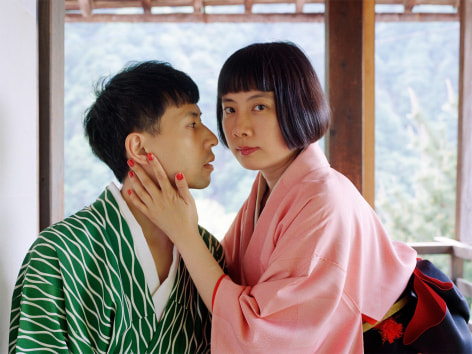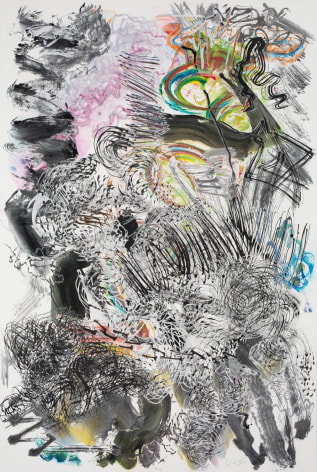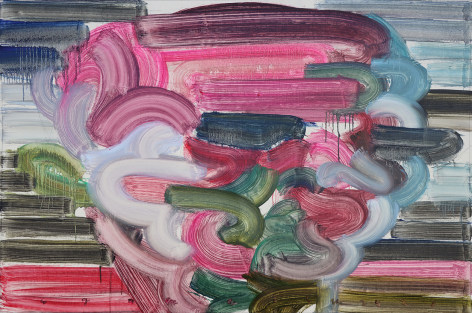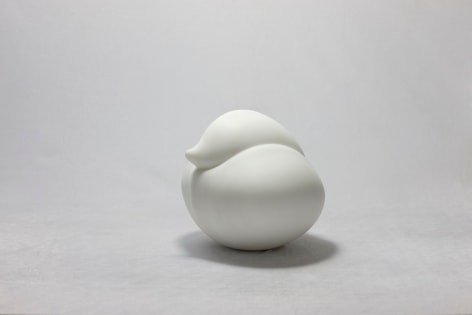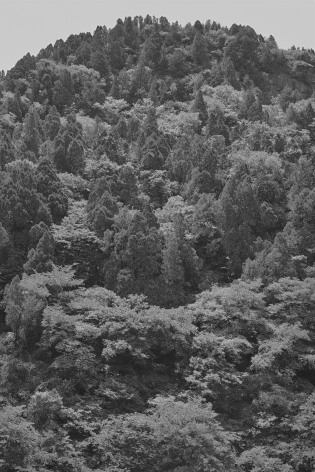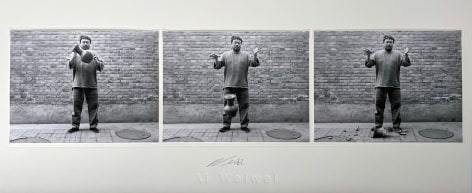Chambers Fine Art is a gallery specializing in contemporary Chinese art founded in New York in 2000. From the mid-1980s onwards in China the growing awareness of international trends in contemporary art resulted in a great deal of daring experimental work that was promptly recognized in the west and began to appear in such international exhibitions as the Venice Biennale and documenta. Recognizing that there was an opportunity to make this work more widely available to a Western audience, Christophe W. Mao opened his gallery in the Chelsea district of New York in 2000, one of the first to have this particular focus. Twenty years later it is a particular pleasure to be able to use the premises of Il Rivellino, the lower level of which has been attributed to Leonardo da Vinci and his work on the fortifications of the Castello Visconteo, Locarno.
AI WEIWEI, WU JIAN’AN
Greeting the visitor to the gallery is a telling display of three works by Ai Weiwei (b. 1957). Widely known for his work in many media and for his support of human rights and free speech wherever these are threatened, he is represented at Il Rivellino by works that encapsulate his deep involvement with the traditional arts of China. After more than a decade spent in the USA, primarily New York, he returned to Beijing and began frequenting the antiques markets that could be found throughout China, collecting and developing considerable expertise. Dropping a Han Dynasty Urn, 2021, is a recently printed version of a performance that took place in Beijing in 1995. Subject to multiple interpretations, it has sometimes been seen as a commentary on the destructiveness of the Cultural Revolution. The two Plates with Flowers, 2014, reveal another aspect of the artist’s involvement with Chinese antiquities, namely deep admiration. Made in Jingdezhen, the center of porcelain manufacture in China for hundreds of years, these ornately decorated plates rival the achievements of the past although they have no known precedent.
While studying at the Central Academy of Fine Arts in Beijing, Wu Jian’an (b.1980) became enamored of the traditional Chinese craft of paper cut, used widely for the creation of decorative designs for all kinds of festivities and auspicious occasions. Since 2003 this technique has been his primary focus although he broadened its range of cultural references and greatly increased the complexity of his designs, creating multi-layered compositions of considerable scale. The five works by Wu Jian’an on display belong to a later series of works executed in 2017 that are known as 500 Brushstrokes. Abandoning the figurative and fantastic imagery of his earlier work he used single brushstrokes, the units used in calligraphy and painting, the classical arts of China, as the building blocks of his own dense compositions. Instead of painting directly on a sheet of paper, however, until the desired result is achieved, he cuts out the individual brushstrokes and reassembles them on another sheet of paper. This is done so skillfully that only close inspection reveals that his dynamic compositions are not what they appear to be. The artist likens the assembled brushstrokes to individuals who melt into a crowd but maintain their individuality.
WANG DONGLING, YAN SHANCHUN, ANGELA LYN
In the adjacent gallery, works by Wang Dongling (b.1945), and Yan Shanchun (b. 1957) and Angela Lyn (1955)more closely approximate the common perception of Chinese art. Wang Dongling is recognized as one of foremost practitioners of calligraphy in China, capable of producing works in all the different styles that have characterized its long history. His calligraphies are included in the collections of major museums throughout the world. However, he is fully aware of the development of abstract art in the West and the degree to which certain strains of abstraction were influenced by Asian calligraphy. His forceful brushstrokes often invoke classics of Chinese poetry but are illegible.
Yan Shanchun has devoted most of his life as a painter to the subject of West Lake in Hangzhou, famous for its beauty and cultural associations. As a student he studied calligraphy and then focused on academic studies for a number of years before returning to painting. At first his paintings of the lake were conventional in format and technique but by 2014 when the four paintings from from the Lake Surface series in the exhibition were executed, his work had become more abstract and adventurous in technique. Focusing on the surface of the lake rather situating it in space through recognizable references to the monuments and landscape surrounding it, he builds up the surface of his canvases by successively painting and erasing until he achieves the multi -layered effect he desires. He conveys the mystery and poetic atmosphere of the lake through the merest suggestion of specific features.
Angela Lyn (b.1955) was educated in England and visited Asia for the first time when she was in her late teens. This visit made a tremendous impression on her although it was some time before she abandoned her early expressionist style for a more subdued manner that focuses on glimpses or small details of objects to convey much broader perspectives. Magnificent cedar trees glimpsed through her studio windows overlooking Lake Lugano provide the inspiration for an ongoing series of works that hover between the sensitive depiction of particular branches and abstraction.
GUO HONGWEI, SONG HONGQUAN
Guo Hongwei (b.1982) grew up in a cultivated household in which there was enormous respect for the cultural achievements of China during several millennia but for the most part the references in his work are entirely contemporary. Immediately after leaving art school he began to focus on his own childhood and adolescence as the theme of many of his works. Like all his contemporaries he was also affected by the internet and the over-abundance of imagery found on social media. He differed, however, in one notable respect, his enthusiasm for and great skill in the watercolor technique. His watercolors vary widely in thematic content, ranging from the humorous and erotic to exquisitely executed studies of natural history specimens, animal, vegetable and mineral.
The sculptures of Song Hongquan (b.1978), executed in dazzling white marble, frequently suggest fragments of human bodies with decidedly erotic overtones. However, for a number of years he has been using seeds as the source of his imagery, greatly enlarging them until the resemblance to the human form is unmistakable. Son of a stone carver, Song is an exception among contemporary Chinese artists, creating pristine forms that have much in common with twentieth century modernist sculpture.
EGAMI ETSU
Unlike the other artists included in Septet, Egami Etsu (b. 1994) is young enough to have had a truly international education, having lived and studied in Japan, Beijing and in Karlsruhe, Germany. During this peripatetic period of her life, she was exposed to a multitude of different approaches to the creation of art, both traditional in Beijing and more conceptual in Germany. Her exhibitions and installations vary widely in style, depending on the situation and local environment, but her dexterity as a painter is never in doubt. In her recent paintings she limits the brushstrokes to a limited number of lushly painted horizontal, vertical and curved strokes from which emerge human features and occasionally other less recognizable themes. For the current exhibition she plans to capitalize on Il Rivellino’ s association with the name of Leonardo de Vinci. As is always the case the painterly ease and sensuous handling of the medium that characterizes her work is strengthened by thoughtful analysis of the theoretical issues implicit in what she does so naturally.


